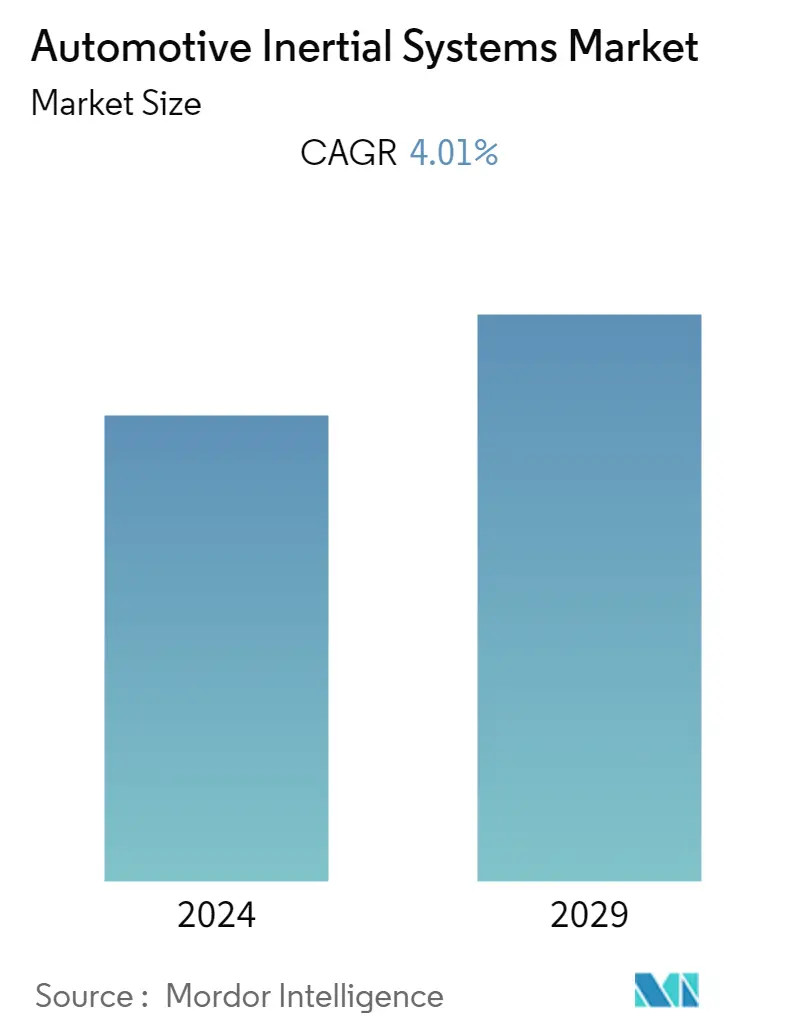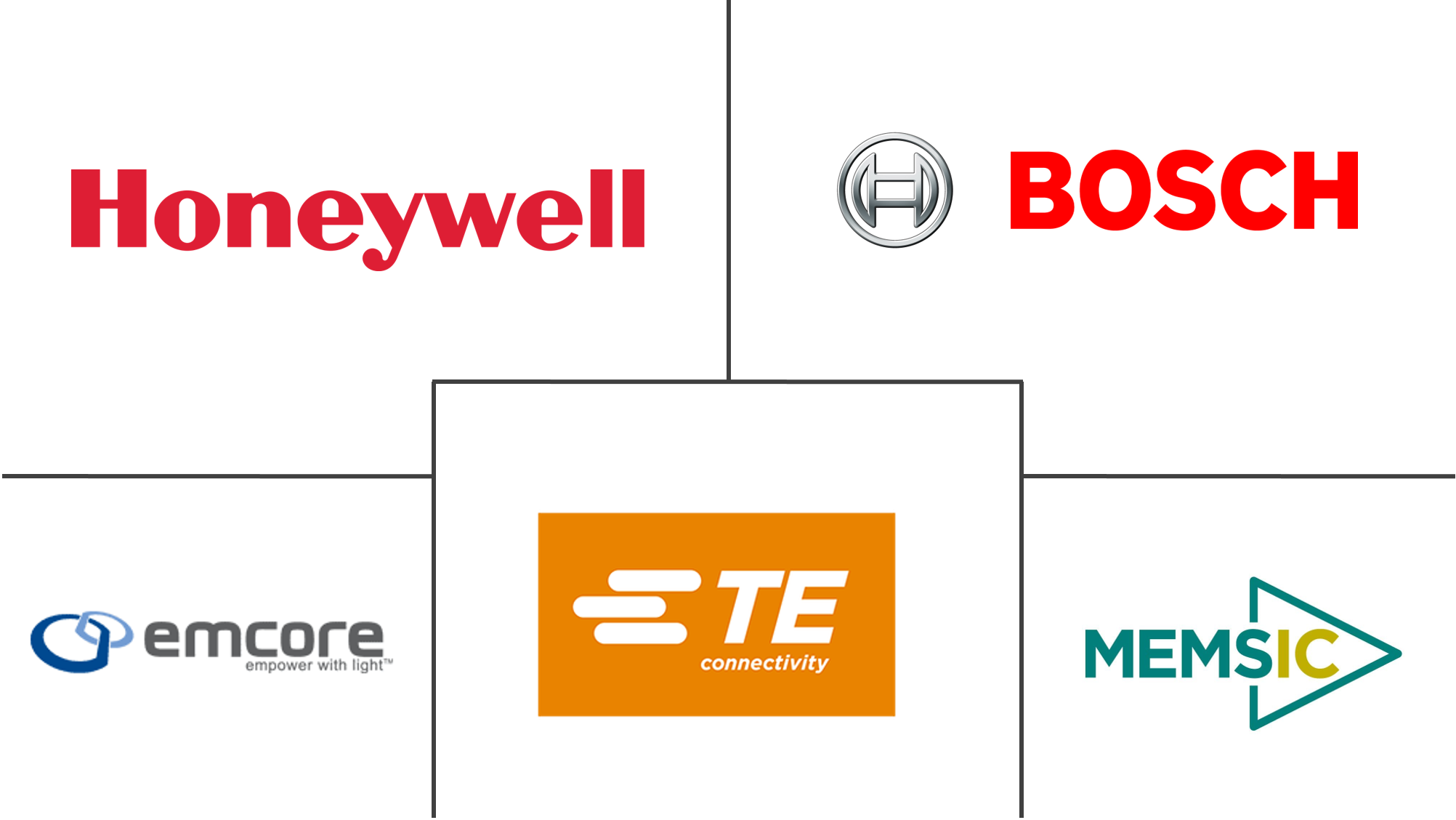Market Size of Automotive Inertial Systems Industry

| Study Period | 2019 - 2029 |
| Base Year For Estimation | 2023 |
| CAGR | 4.01 % |
| Fastest Growing Market | Asia Pacific |
| Largest Market | North America |
| Market Concentration | Medium |
Major Players
*Disclaimer: Major Players sorted in no particular order |
Automotive Inertial Systems Market Analysis
The Automotive Inertial Systems Market was valued at USD 1871.1 million in 2020 and expected to reach USD 2361.31 million by 2026 and grow at a CAGR of 4.01% over the forecast period (2021 - 2026). Inertial systems comprise IMUs in combination with high-performance sensors (gyroscopes, magnetometers, and accelerometers), to provide high-accuracy information about the surrounding environment, through relative movement. The powerful combination of IMUs with other onboard sensors produces critical data increasing the reliability of the vehicles and leading to new automation breakthroughs in automotive applications.
- The emergence of micro-electromechanical systems (MEMS) technology resulted in the miniaturization of mechanical and electro-mechanical elements in the field of sensors and semiconductors, with the help of micro-fabrication and micro-machining techniques. Hence, MEMS has now become an important part of several automation components in Level 1, 2, and 3 autonomous cars, boosting demand for inertial systems from the automotive sector significantly.
- The growing demand for safety in automobiles is boosting the market's growth positively. According to the World Health Organization, globally, approximately 1.35 million people are killed in road accidents every year. Moreover, between 20 and 50 million more people suffer non-fatal injuries, with many incurring a disability as the result of their injury. MEMS accelerometers play an important role in improving the safety features of vehicles.
- The current generation of automobiles highly relies on the collection of data from various sensors used in the vehicle. Gyroscopes and accelerometers provide essential measurements for improving the control and stability of the vehicle. Both these sensors are liable to make significant noise at low frequency, resulting in low accuracy of the measurements, especially under the low-dynamic conditions, thereby accelerating the market demand during the forecast period.
Automotive Inertial Systems Industry Segmentation
| By Component | |
| Accelerometer | |
| Gyroscope | |
| Inertial Measurement Systems (IMU) | |
| Inertial Navigation Systems (INS) | |
| Other Components |
| Geography | |
| North America | |
| Europe | |
| Asia-Pacific | |
| Latin America | |
| Middle East & Africa |
Automotive Inertial Systems Market Size Summary
The automotive inertial systems market is experiencing growth driven by the integration of Inertial Measurement Units (IMUs) and advanced sensors like gyroscopes, magnetometers, and accelerometers. These systems are crucial for enhancing vehicle reliability and enabling automation in automotive applications. The advent of micro-electromechanical systems (MEMS) technology has significantly contributed to this market by miniaturizing components, thereby boosting the demand for inertial systems in autonomous vehicles. The increasing emphasis on vehicle safety, coupled with the role of MEMS accelerometers in enhancing safety features, is further propelling market expansion. The reliance on data from various sensors for vehicle control and stability is also a key factor influencing market growth, despite challenges such as sensor noise affecting measurement accuracy.
Regionally, Asia-Pacific stands out as a significant market for automotive inertial systems, with countries like China, Japan, and India driving demand through high-volume production. However, recent sluggish sales in some areas have been noted. The electric vehicle (EV) market is gaining traction in China and India, supported by government initiatives and policy announcements, which are expected to further influence the demand for inertial systems. The market is moderately competitive, with major players holding significant shares, yet advancements in sensor technology are allowing new entrants to expand their presence in emerging economies. Notable developments include Honeywell's launch of the HGuide i300 and Emcore's addition to the Orion series, highlighting ongoing innovation in the sector.
Automotive Inertial Systems Market Size - Table of Contents
-
1. MARKET DYNAMICS
-
1.1 Market Overview
-
1.2 Market Drivers
-
1.3 Market Restraints
-
1.4 Industry Value Chain Analysis
-
1.5 Industry Attractiveness - Porter's Five Force Analysis
-
1.5.1 Threat of New Entrants
-
1.5.2 Bargaining Power of Buyers/Consumers
-
1.5.3 Bargaining Power of Suppliers
-
1.5.4 Threat of Substitute Products
-
1.5.5 Intensity of Competitive Rivalry
-
-
-
2. MARKET SEGMENTATION
-
2.1 By Component
-
2.1.1 Accelerometer
-
2.1.2 Gyroscope
-
2.1.3 Inertial Measurement Systems (IMU)
-
2.1.4 Inertial Navigation Systems (INS)
-
2.1.5 Other Components
-
-
2.2 Geography
-
2.2.1 North America
-
2.2.2 Europe
-
2.2.3 Asia-Pacific
-
2.2.4 Latin America
-
2.2.5 Middle East & Africa
-
-
Automotive Inertial Systems Market Size FAQs
What is the current Automotive Inertial Systems Market size?
The Automotive Inertial Systems Market is projected to register a CAGR of 4.01% during the forecast period (2024-2029)
Who are the key players in Automotive Inertial Systems Market?
Honeywell International Inc., Robert Bosch GmbH, MEMSIC Inc., TE Connectivity Ltd and EMCORE Corporation are the major companies operating in the Automotive Inertial Systems Market.

